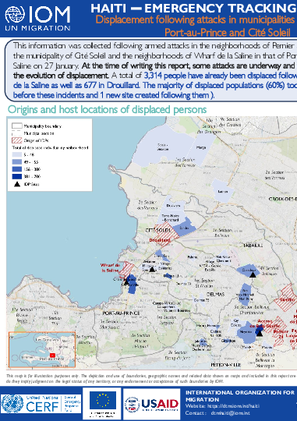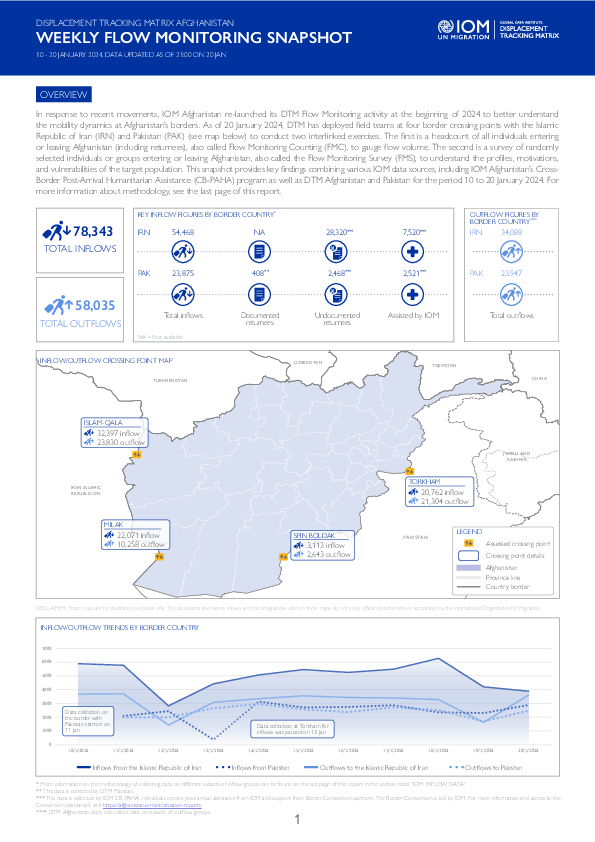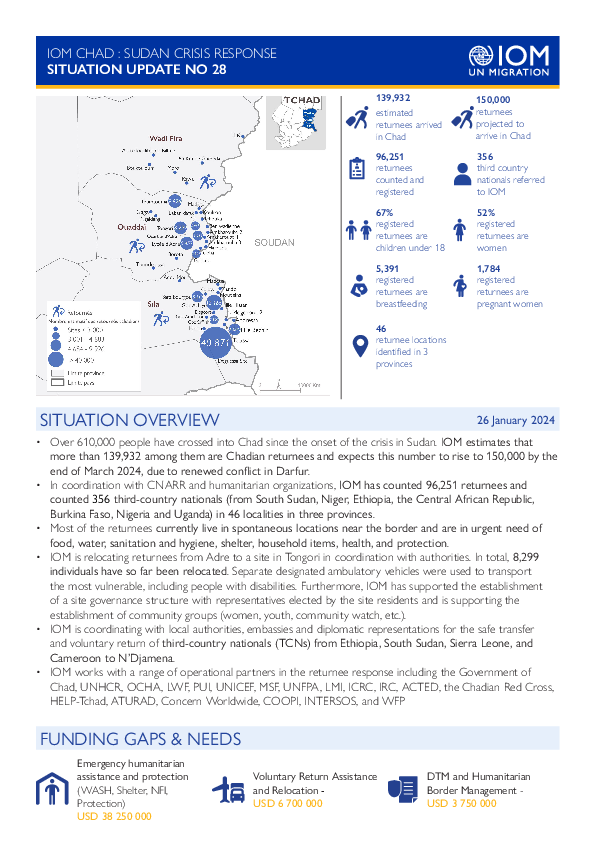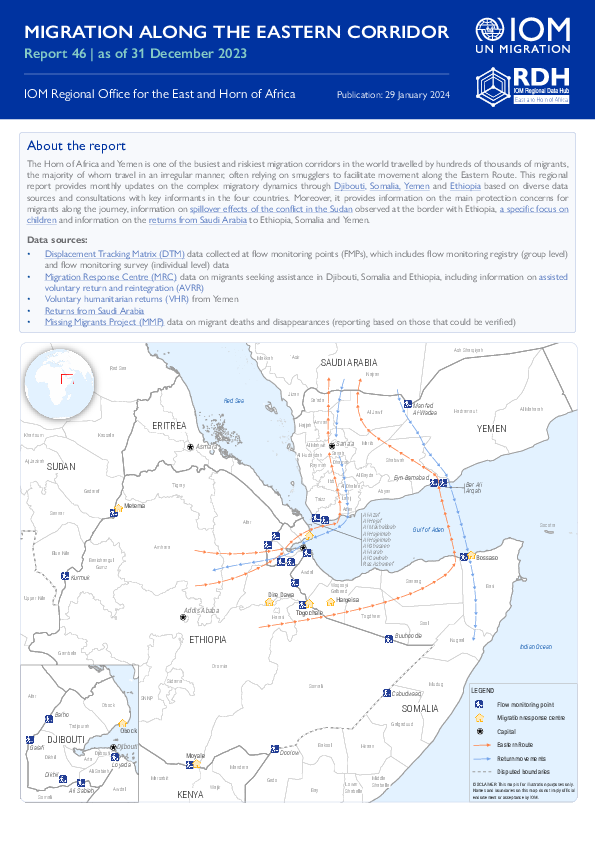-
Countries
-
Data and Analysis
-
Special Focus
-
Crisis Responses
Contact
dtmlebanon@iom.int
Location
Lebanon
Activity
- Mobility Tracking
- Baseline Assessment
Period Covered
Oct 10 2023 -Jan 23 2024
Since October 8 there has been an increase in cross-border incidents between Israel and Lebanon, resulting in the displacement of people both within the South and elsewhere within the country. Since October 10, the Displacement Tracking Matrix (DTM) has been conducting the daily monitoring of population movements. The objective of the exercise is to inform preparedness and response planning.
Population Groups
IDPs
Survey Methodology
Unit of Analysis Or Observation
Admin Area 2
Admin Area 3
Household
Individual
Type of Survey or Assessment
Household
Key Informant
Keywords
Geographical Scope Full Coverage
Administrative boundaries with available data
The current dataset covers the following administrative boundaries

Contact
dtmhaiti@iom.int
Language
English
Location
Haiti
Period Covered
Jan 27 2024
Jan 31 2024
Activity
- Mobility Tracking
- Event Tracking
This information was collected following armed attacks in the neighborhoods of Pernier and its surroundings in the municipality of Pétion Ville, in the neighborhoods of Drouillard in the municipality of Cité Soleil and the neighborhoods of Wharf de la Saline in that of Port- au-Prince. Attacks in Pernier and Drouillard began on 30 January 2024 and at Wharf de la Saline on 27 January. At the time of writing this report, some attacks are underway and the displacement of populations as a result. Updates will be published by DTM according to the evolution of displacement. A total of 3,314 people have already been displaced following these attacks, including 1,398 following attacks in Pernier, 1,239 following those at Wharf de la Saline as well as 677 in Drouillard. The majority of displaced populations (60%) took refuge with host families and 40% in sites (1,331 people in 4 sites including 3 existing sites before these incidents and 1 new site created following them ).
Contact
DTMChad@iom.int
Location
Chad
Activity
- Mobility Tracking
- Site Assessment
- Village Assessment
Period Covered
Oct 05 2023 -Nov 08 2023
From October 5th 2023 to November 8th 2023, the DTM team in Chad has conducted the round 21 of Sites and Villages assessment accross 281 locations.
During this round, a total of 242,205 displaced individuals were identified, including 199,198 internally displaced persons, 27,090 internal returnees and 15,718 returnees from abroad.
Population Groups
IDPs
Returnee (Previously Displaced Abroad)
Returnee (Previously Internally Displaced)
Survey Methodology
Unit of Analysis Or Observation
Admin Area 2
Admin Area 3
Site
Site or Location
Type of Survey or Assessment
Key Informant
Keywords
Geographical Scope Partial Coverage
Administrative boundaries with available data
The current dataset covers the following administrative boundaries

Contact
DTM Burundi, DTMBurundi@iom.int
Language
French
Location
Burundi
Period Covered
Jan 21 2024
Jan 27 2024
Activity
- Mobility Tracking
- Event Tracking
La DTM a identifié 2 785 personnes affectées, dont 141 personnes déplacées par les pluies torrentielles et la grêle dans les provinces de Cankuzo, Kayanza, Gitega, Rutana et Makamba.

Contact
DTMAfghanistan@iom.int
Language
English
Location
Afghanistan
Period Covered
Jan 10 2024
Jan 20 2024
Activity
- Survey
- Flow Monitoring Survey
- Flow Monitoring
In response to recent movements, IOM Afghanistan re-launched its DTM Flow Monitoring activity at the beginning of 2024 to better understand the mobility dynamics at Afghanistan’s borders. Since 10 January, DTM has deployed field teams at four border crossing points with the Islamic Republic of Iran (IRN) and Pakistan (PAK) (see map below) to conduct two interlinked exercises. The first is a headcount of all individuals entering or leaving Afghanistan (including returnees), also called Flow Monitoring Counting (FMC), to gauge flow volume. The second is a survey of randomly selected individuals or groups entering or leaving Afghanistan, also called the Flow Monitoring Survey (FMS), to understand the profiles, motivations, and vulnerabilities of the target population. This snapshot provides key findings combining various IOM data sources, including IOM Afghanistan’s Cross-Border Post-Arrival Humanitarian Assistance (CB-PAHA) program as well as DTM Afghanistan and Pakistan for the period 10 to 20 January 2024. An interactive dashboard on all data collected since the inception of the Flow Monitoring activity on 10 January can be found HERE.

Contact
mtmuzbekistan@iom.int
Language
English
Location
Uzbekistan
Period Covered
Apr 01 2024
Sep 30 2024
Activity
- Flow Monitoring Survey
- Migrants presence
- Mobility Tracking
Mazkur hisobot 2023-yilning aprel-sentabr oylari uchun ichki va tashqi ko‘chishlar hamda migrantlar guruhlari bo‘yicha milliy va xalqaro maʼlumotlar to‘plamlaridan olingan ochiq maʼlumotlarga asoslanib, O‘zbekistondagi migratsiyaga oid so‘nggi maʼlumotlar va jarayonlarni qamrab oladi. Hisobot mamlakatdagi ichki va xalqaro migratsiyaga ta’sir ko‘rsatuvchi so‘nggi yirik global va mintaqaviy voqealarni, xususan, Rossiyaning Ukrainaga bosqini davom etishi hamda buning natijasida mintaqadagi an’anaviy insonlar mobillligi shakllarining o‘zgarishi, shuningdek, urbanizatsiya jarayoni, iqlim o‘zgarishi va o‘sib borayotgan suv tanqisligi kabi masalalar insonlar mobilligini ta’minlovchi omillar sifatida aks ettiradi.
The Horn of Africa and Yemen is one of the busiest and riskiest migration corridors in the world travelled by hundreds of thousands of migrants, the majority of whom travel in an irregular manner, often relying on smugglers to facilitate movement along the Eastern Route. This regional report provides monthly updates on the complex migratory dynamics through Djibouti, Somalia, Yemen and Ethiopia based on diverse data sources and consultations with key informants in the four countries. Moreover, it provides information on the main protection concerns for migrants along the journey, information on the spillover effects of the conflict in the Sudan observed at the border with Ethiopia, a specific focus on children and information on the returns from Saudi Arabia to Ethiopia, Somalia and Yemen.

Contact
DTM Chad, dtmtchad@iom.int
Language
English
Location
Chad
Period Covered
Jan 26 2024
Jan 26 2024
Activity
- Mobility Tracking
- Event Tracking
Over 610,000 people have crossed into Chad since the onset of the crisis in Sudan. IOM estimates that more than 139,932 among them are Chadian returnees and expects this number to rise to 150,000 by the end of March 2024, due to renewed conflict in Darfur.
• In coordination with CNARR and humanitarian organizations, IOM has counted 96,251 returnees and counted 356 third-country nationals (from South Sudan, Niger, Ethiopia, the Central African Republic, Burkina Faso, Nigeria and Uganda) in 46 localities in three provinces.
• Most of the returnees currently live in spontaneous locations near the border and are in urgent need of food, water, sanitation and hygiene, shelter, household items, health, and protection.
• IOM is relocating returnees from Adre to a site in Tongori in coordination with authorities. In total, 8,299 individuals have so far been relocated. Separate designated ambulatory vehicles were used to transport the most vulnerable, including people with disabilities. Furthermore, IOM has supported the establishment of a site governance structure with representatives elected by the site residents and is supporting the establishment of community groups (women, youth, community watch, etc.).
• IOM is coordinating with local authorities, embassies and diplomatic representations for the safe transfer and voluntary return of third-country nationals (TCNs) from Ethiopia, South Sudan, Sierra Leone, and Cameroon to N’Djamena.
• IOM works with a range of operational partners in the returnee response including the Government of Chad, UNHCR, OCHA, LWF, PUI, UNICEF, MSF, UNFPA, LMI, ICRC, IRC, ACTED, the Chadian Red Cross, HELP-Tchad, ATURAD, Concern Worldwide, COOPI, INTERSOS, and WFP

Contact
DTMUkraine@iom.int
Language
English
Location
Ukraine
Period Covered
Jan 02 2024
Jan 11 2024
Activity
- Mobility Tracking
This report serves to identify the heating systems employed in Ukrainian households, presents the estimated prices of solid fuel items across different oblasts, and examines the methods and frequency of solid fuel collection by the Ukrainian population. The report investigates the current and future demand, supply, and prices of essential solid fuel products. The overarching objective is to support ongoing humanitarian winterization operations.
Between 2 and 11 January 2024, the Data and Analytics (D&A) team surveyed 287 markets in 23 oblasts and Kyiv City in Ukraine, conducting face-to-face and remote interviews with both local vendors and community focal points (CFPs). In each oblast, data was collected in at least two locations, one urban and one rural and/or near frontline locations, where applicable. In each location, a minimum of two vendors and two CFPs (non-vendors) were surveyed. The CFPs were chosen based on their familiarity with the subject matter and knowledge of winterization preparation at the community level.

Contact
iombuenosaires@iom.int
Language
Spanish
Location
Argentina
Period Covered
Aug 01 2023
Sep 30 2023
Activity
- Survey
- Flow Monitoring Survey
Actualmente, se estima que aproximadamente 7, 7 millones de personas de nacionalidad venezolana se encuentran fuera de la República Bolivariana de Venezuela1 , de las cuales 6.5 millones residen en países de América Latina y el Caribe. En la República Argentina, residen más de 200.000 personas venezolanas , siendo este flujo poblacional uno de los más dinámicos en años recientes en un país históricamente receptor de inmigración. La magnitud de este movimiento de población resulta inédita en la historia reciente de América Latina y el Caribe e involucra tanto a refugiados como migrantes de aquel país.
La experiencia demuestra que los movimientos poblacionales a gran escala persisten y se pueden complejizar en ausencia de soluciones políticas y solidaridad internacional continua. Dada la magnitud de la salida de personas venezolanas, solo un enfoque integral y coordinado a nivel regional entre los gobiernos, con el apoyo de la comunidad internacional, permitirá a la región hacer frente a la magnitud de este influjo.
Con este objetivo en mente, el Plan Regional de Respuesta para Refugiados y Migrantes Venezolanos (RMRP, por sus siglas en inglés) se ha desarrollado para apoyar y complementar la labor de las autoridades nacionales de América Latina y el Caribe, respondiendo a las necesidades de la población de manera integral y exhaustiva y en el marco de los mecanismos regionales de respuesta y coordinación.
Desde 2018 OIM Argentina ha implementado la Matriz de Seguimiento del Desplazamiento (DTM, por sus siglas en inglés) en su modalidad de Encuesta de Monitoreo de Flujos (en diversos puntos de ingreso al territorio nacional y de estancia). La DTM es un sistema para monitorear movimientos de población y cuenta con una variedad de herramientas de medición.
Cada una de ellas puede ser adaptada para dar seguimiento de forma sistemática y regular al desplazamiento de personas en diversos contextos. Su objetivo principal consiste en conocer el perfil y mejorar la comprensión de las necesidades de la población que se moviliza en diferentes situaciones.
Desde 2018, la implementación de la DTM en la República Argentina ha tenido como objetivos: caracterizar a la población venezolana que arriba o que reside en el país, para conocer sus aspectos sociodemográficos, las rutas recorridas, su situación migratoria, laboral, sus posibilidades de acceso a la salud, a los alimentos, a la vivienda y a la información. También se indaga acerca de las necesidades concretas de asistencia y sobre los procesos de reunificación familiar que las personas encuestadas consideran experimentarán en el corto o mediano plazo. La DTM ronda 15 se realizó durante los meses de agosto y septiembre de 2023. Las encuestas se aplicaron en la Ciudad Autónoma de Buenos Aires, Ciudad de Córdoba (Córdoba) y Rosario (Santa Fe).
